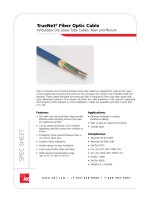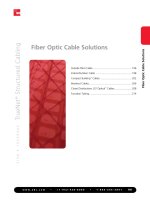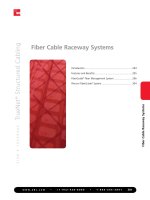Basic fiber optic system
Bạn đang xem bản rút gọn của tài liệu. Xem và tải ngay bản đầy đủ của tài liệu tại đây (1.81 MB, 63 trang )
Fiber Optics
Basic Fiber-Optic System
• Transmitter (laser diode or LED).
• fiber-optic cable.
• Receiver (PIN diode or avalanche
photodiode).
• Most fiber systems are digital but analog is
also used.
Fiber Structure
• Core and cladding are both transparent,
usually glass, sometimes plastic.
• Core has higher index of refraction.
• Light propagates down the core, reflecting
from cladding.
Fiber Communication
Fiber Advantages
•
•
•
•
•
•
•
Greater bandwidth than copper cable or radio link.
Lower loss than cable or radio.
Immunity to crosstalk and EMI.
Greater security from eavesdropping.
No spark hazard.
Less time delay than geostationary satellites.
Smaller size and weight than copper cables.
Optical Fiber Operation
• Fiber works using total internal reflection.
• Core has higher index of refraction than
cladding.
• If angle of incidence of light to the interface
between core and cladding is great enough,
light will be reflected back into core.
Index of Refraction
c
n=
v
= εr
1
=
vf
Snell’s Law
n1 sin θ1 = n2 sin θ 2
n1
sin θ 2 = sin θ1
n2
Critical Angle
• If angle of incidence is such that angle of
refraction is 90°, reflection takes place
instead of refraction
n2
sin θ c =
n1
n2
θ c = arcsin
n1
Numerical Aperture
• derived from critical angle.
• sine of max. angle a ray can have with the
axis of the fiber and still propagate.
2
N . A. = n1 − n2
2
.
Modes of Propagation
• Fiber is a waveguide for light.
• Both single-mode and multimode
propagation are used in fiber --- only singlemode is used in microwave waveguides.
• Dispersion is greater with multimode
propagation but fiber core is larger and
easier to use.
Graded-Index Multimode Fiber
• Index of refraction of core increases toward
the center.
• Has less dispersion than step-index
multimode fiber (but more than single-mode
fiber)
Fiber Types
SM step index
MM step index MM graded index
Single-mode Propagation
• As for microwave waveguides, only the
dominant mode must propagate.
• Requires small core diameter.
• cladding can be the same as for multimode.
rmax
0.383λ
=
N . A.
Dispersion in Multimode Fiber
• Caused by different group velocities of
different modes.
• Called intermodal dispersion.
• Dispersion is proportional to length.
• Intramodal dispersion, discussed next, is
also present but negligible in multimode
fiber compared with intermodal dispersion.
.
Dispersion in Single-Mode Fiber
• No intermodal dispersion, only intramodal.
• Material dispersion is caused by different
propagation velocities for different
wavelengths.
– Even laser light is not perfectly
monochromatic.
– Material dispersion is also called chromatic
dispersion.
Dispersion in Single-Mode Fiber
• Waveguide dispersion
– Caused by propagation in the cladding.
– Core and cladding have different propagation
velocities.
• Waveguide dispersion and material dispersion can
cancel at one wavelength creating a zerodispersion wavelength.
• Zero-dispersion wavelength 1.3 µm in glass.
Dispersion in Single-Mode Fiber
• Dispersion in single-mode fiber is
proportional to both source linewidth and
distance.
Dispersion Specifications
• Dispersion is specified differently for multimode
and single-mode fiber.
• Multimode: expressed as a bandwidth-distance
product (MHz-km).
• Single-mode: expressed as a time variation:
ps/(nm-km).
• In both units the - represents multiplation sign × .
Bandwidth-Distance Product
• Bandwidth refers to signal bandwidth in MHz.
– the linewidth of the source is not a serious contributor
to dispersion in multimode cable.
• Distance is the length of the fiber between
transmitter and receiver or between regenerative
repeaters, in km.
• Greater bandwidth is possible over shorter
distances.
Calculating Single-Mode
Dispersion
• Total dispersion is
∆t = Dc ∆λl
∆t = total dispersion in ps
Dc = fiber dispersion in ps/nm/km
∆λ = source linewidth in nm
l = fiber length in km
Dispersion-Bandwidth
Equivalence
• Conversion is approximate only
• Based on idea that transmission of the
fundamental frequency of a square wave is
all that is necessary
1
B≈
2∆t
.









